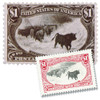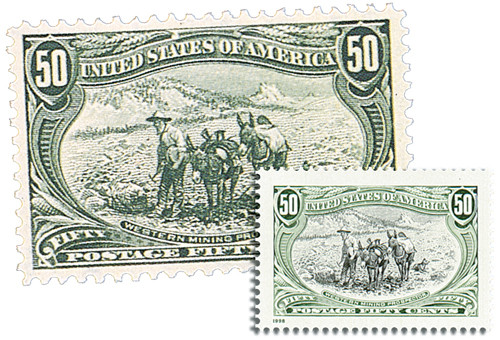#292 Cattle in Snowstorm. Add this gem to your U.S. Collection in used condition with minor imperfections. Act now and also get the #3209h, 1998 re-print, free.
U.S. #292
1898 $1 Trans-Mississippi Exposition
First Day of Issue: June 17, 1898
Quantity issued: 56,900 (unknown quantity later destroyed)
Printed by: Bureau of Engraving and Printing
Method: Flat Plate in sheets of 100 subjects
Watermark: Double-line watermark USPS
Perforation: 12
Color: Black
The one dollar Trans-Mississippi Exposition commemorative stamp pictures a rugged bull leading a herd of cattle through a snowstorm. Although the series was intended to portray scenes from the American West, the design is based on a painting by Scottish artist J. A. MacWhirter entitled “The Vanguard.” Painted in a small farmhouse near the Scottish town of Calendar, the scene is actually of Scotch cattle in the West Highlands. The work of art had been used in advertisements for an American cattle company, who used it as a trademark without permission.
After the stamp was printed, officials learned the painting was the property of British Lord Blythswood. An official apology was issued through the offices of the British Ambassador, who was satisfied with the outcome.
The $1 Trans-Mississippi stamp was designed by Raymond Ostrander Smith, the Bureau of Engraving and Printing’s chief staff designer. The stamp features the same border as the rest of the values. Unlike the 1893 Columbian series, the Trans-Mississippi Exposition commemoratives didn’t include the name or dates of the event. Instead, each stamp features a caption with the name of the photograph or painting upon which its design is based.
Stamp collectors weren’t concerned with the accuracy of the design. Western Cattle in Storm is often referred to as the most beautiful stamp ever issued by the U.S. In addition to being visually appealing, the stamp is also quite scarce. Only 56,900 U.S. #292 stamps were issued, and an unknown quantity of unsold stamps were destroyed. To complicate matters more, the 1893 Columbian series was still on sale and many collectors were trying to complete it.
Printed by the Bureau of Engraving and Printing
The Trans-Mississippi commemorative stamps were printed by the Bureau of Engraving and Printing. Original plans called for the series to be printed in bi-color. A red frame with a black vignette (center design) was planned for the $1 Western Cattle in Storm stamp. However, the Spanish-American War strained the resources of the Bureau of Engraving and Printing, which was overburdened by the demand for revenue stamps to fund the war. The Trans-Mississippi commemoratives were printed in a single color, with the $1 denomination printed with black ink.
The entire printing run of U.S. #292 lasted only three days from June 1-3, 1898. There are no significant plate varieties or shades. Twenty percent of the stamps feature a straight edge, leaving 45,520 copies with original perforations on all four sides (and probably less, since we know many unsold stamps were destroyed).
About the 1898 Trans-Mississippi Exposition Series
The 1898 Trans-Mississippi and International Exposition was held to further the progress and development of natural resources west of the Mississippi River. Held in Omaha, Nebraska, the exposition opened on June 1, 1898, and ran for four months. More than 4,000 exhibits showcased social, economic, and industrial resources of the American West. The expo wasn’t a financial success overall, but it did revitalize Omaha, a community that had been devastated by drought and depression.
Over 2.6 million people attended the expo, which featured the Indian Congress, the largest Native American gathering of its kind. Over 500 members representing 28 tribes camped on the fairgrounds and introduced Americans from the East to their way of life. Reenactments of the explosion of the battleship Maine also fueled patriotism and support for the Spanish-American War.
The Most Beautiful U.S. Stamp?
While Western Cattle in Storm is widely considered the most beautiful U.S. stamp, it has had its critics. In 1902, respected philatelic writer and editor of the Scott Catalogue John Luff was less than flattering. “The stamps are poorly conceived and executed, overloaded with ornaments, heavy in color and blurred in painting.”
Luff represented the minority opinion. In 1933, author Ralph Kimble described the Trans-Mississippi stamps as “perhaps the most attractive set of commemoratives which we have ever had,” with additional flattery for the $1 stamp.
In 1934, Stamps magazine asked readers to cast their votes for the most beautiful stamp in the world. The 1928 50¢ Bluenose Canada stamp won first place, while Western Cattle in Storm placed second. Over 70 years later, U.S. #292 was voted #6 in 100 Greatest American Stamps.












